Henry Barraud
British, (1811-1874)Horses & grooms at Mount Mascal
Oil on canvas, signed
This wonderful scene by Henry Barraud depicts horses with their grooms and a carriage outside the coach house of a country estate. As one pair of harnessed horses are guided to the carriage the other waits patiently. The well-kept carriage, most likely a Berline or Landau was the epitome of luxury at the time. The painting not only offers us a glimpse of how the wealthy lived during the 19th century but also the way personal transport needed to be organised.
The work retains a handwritten label (see image) on the back, which has most likely been transcribed (sic) from an original inscription, and reads: “Coach, Stables Horses & Grooms at Mount Marshall (sic) near Chislehurst, Kent, (Andrew Lawrie) by Barraud”. Extensive research has revealed that the house referred to in the transcription is Mount Mascal, a country estate built C1600 on the hillside overlooking North Cray, Bexley by the Mascal family. During the mid to late 19th century it was owned by Andrew Lawrie/Laurie who was from a very wealthy family. He was born in 1825 and is recorded as living at Mount Mascal in the local registered voters list of 1857 and 1868. Lawrie most likely commissioned the painting from Barraud after purchasing the property, possibly after his marriage in 1855 to Mary Eleanor Johnson. He died in 1884, aged 60. The house was then sold to the Vesey-Holt family. From the early 19th century the estate began to be broken up and sold, with the house itself being demolished in the late 1950s.
Henry Barraud was an animal, portrait and subject painter born in Camberwell, London in 1811. He was the son of William Francis Barraud, a clerk at Custom House and Sophie Hull, daughter of Thomas Hull, the miniature painter. His paternal grandfather was Paul Philip Barraud the eminent chronometer maker. His older brother was the animal artist William Barraud (1810-1850). Whilst little is known about his early education, he most likely received art tuition alongside his brother. Like William, he initially joined his father working as a clerk in the Customs office. However, they both left to become artists with Henry going on to study under J. J Middleton.
The two brothers shared a studio and lived together in a number of locations including Champion Hill, Camberwell and 9, Exchange Buildings in the City. They also collaborated on a number of paintings. Henry began exhibiting at the Royal Academy in 1833 until 1859 and as well as his solo works exhibited the collaborative works with his brother from 1836 until 1849. He also exhibited at the British Institution and at the Royal Society of British Artists from 1835, again both on his own and also with some of the works he painted with William. Both Henry and his brother painted a number of scenes of Florence and Rome during the early 1840’s which indicates they could well have travelled to Italy together.
Barraud married Anna Maria Rose on 14, September 1842. The couple lived at 77 Park Street, Grosvenor Square and went on to have 9 children together. Two of their sons, Mark Henry Barraud (1846-1887) and Francis James Barraud (1856-1924) also became artists. He spent his time travelling around the country often painting on commission. Some of his patrons included the Earl of Arundel and the Earl of Coventry. His most famous works included ‘We praise Thee, O God’, ‘The London Season, a scene in Hyde Park’, ‘Lord's Cricket Ground’, and ‘The Lobby of the House of Commons’. A number of his paintings including his most popular were reproduced as engravings, some of which were published in the Sporting Magazine.
By 1851, he was living at 23, Campden Gove, Kensington before making his final move to 96 Gloucester Place where he spent his remaining years. He died at Gloucester Place on 17 June, 1874 at the age of 64. Examples of his work are held by the British Library, Cooper Gallery, Hunterian Museum, Museum of London, National Army Museum, Newstead Abbey, Northampton Museum, Towneley hall Art Gallery and the Yale Centre for British Art.
© Benton Fine Art
| Presentation | The painting is housed in a new, English made gilt frame which is in excellent condition. |
| Condition | As with all of our original antique oil paintings, this work is offered in ready to hang gallery condition, having been professionally cleaned, restored and revarnished. |
Dimensions
| Image Size | 15.25 inches x 29.25 inches (39cm x 74.5cm) |
| Framed Size | 21.25 inches x 35.25 inches (54cm x 89.5cm) |
You May Also Like










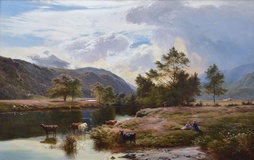
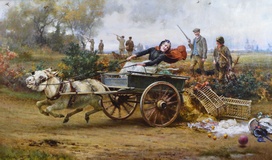
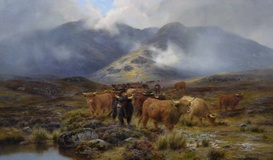
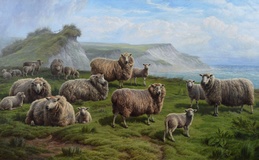
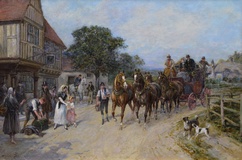
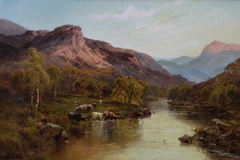
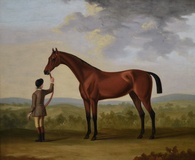

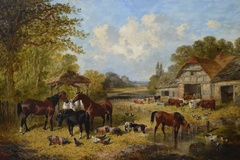
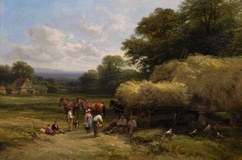
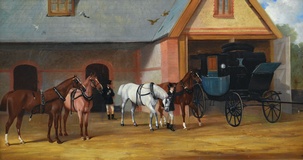 Horses & grooms at Mount Mascal - Henry Barraud
Horses & grooms at Mount Mascal - Henry Barraud

